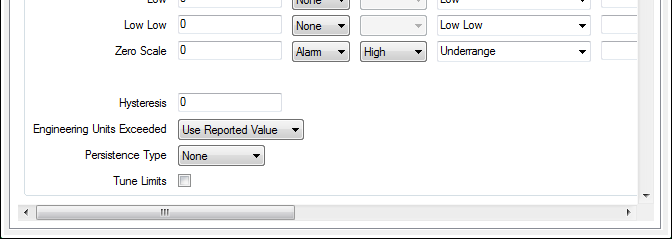The Hysteresis feature allows you to define the amount by which an analog point’s value has to decrease below a high limit, or increase above a low limit, for an alarm to be cleared. This helps to ensure that an analog point’s alarms are not continuously raised then cleared if its value fluctuates around an alarm limit.
The Hysteresis field is displayed within the Alarm Limits section, typically on the Analog Point tab of the Analog Point Form.

To define the Hysteresis amount:
- Display the Form for the analog point that you want to configure (see Display a Form in the ClearSCADA Guide to Core Configuration).
- Select the Analog Point tab.
(If you are configuring the hysteresis for another point that uses analog-type processing, select the appropriately named <Point Type> tab. If you are configuring a separate server-based hysteresis, select the Master Station Alarm Limits tab.) - Enter the Hysteresis amount in the Hysteresis field.
- Save the configuration (see Saving Configuration Changes in the ClearSCADA Guide to Core Configuration).
Example:
The High limit of an analog point is defined as 50.
The Hysteresis for the analog point is defined as 5.
The value of the analog point changes from 48 (Normal) to 51 (High). An alarm is raised.
The value of the analog point changes from 51(High) to 49 (Normal). Although the value has re-entered the Normal range of limits, the alarm is not cleared, as the point value has not decreased by the Hysteresis amount. The alarm will only clear when the point value changes to 45 or lower, as 50 - 5 (limit minus hysteresis) = 45.